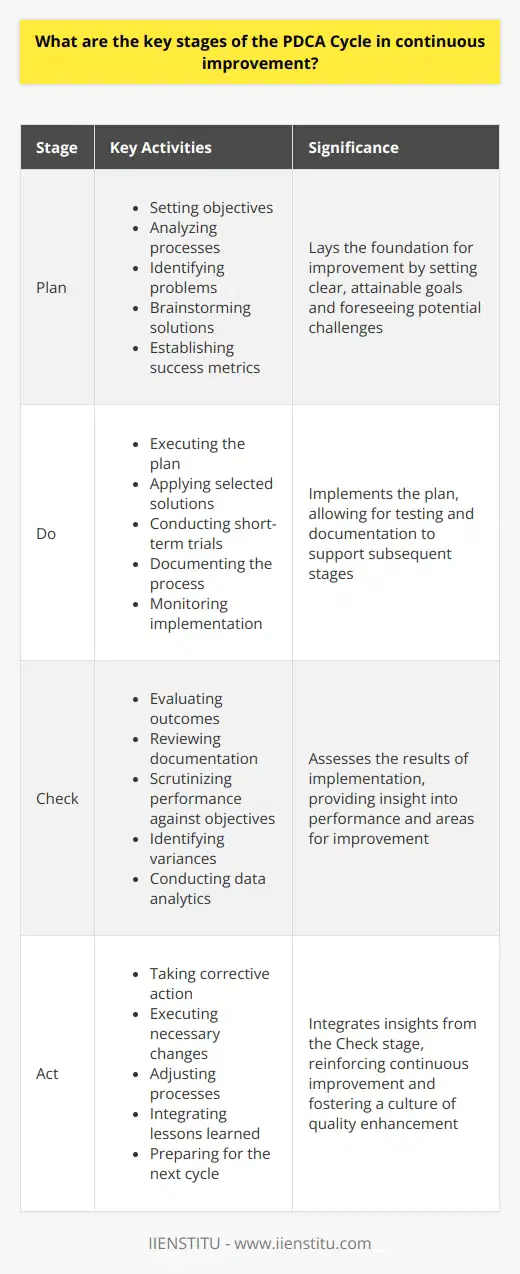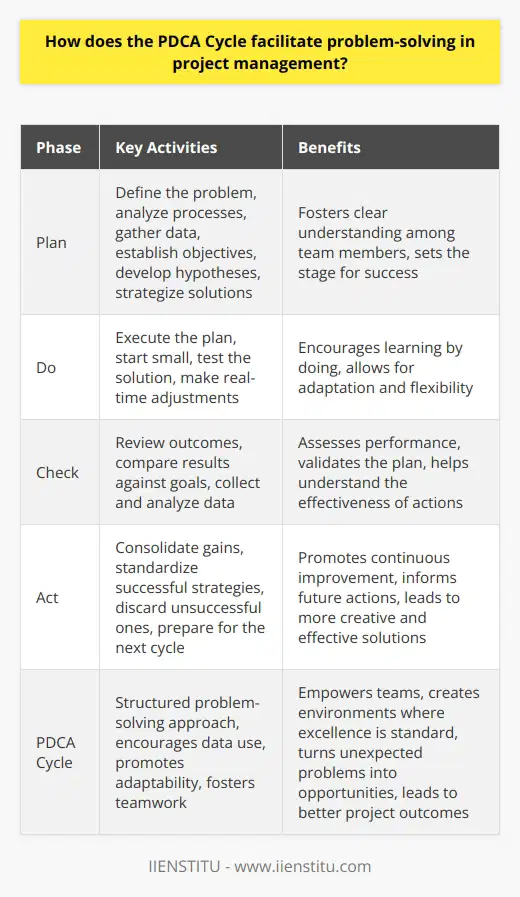
When I first stepped into the world of business management, I was overwhelmed by the myriad of strategies and methodologies that promised efficiency and success. Among them, one concept stood out and resonated with my innate desire for continuous growth: the PDCA Cycle. This simple yet profound tool, standing for Plan, Do, Check, Act, became a cornerstone in my journey towards fostering operational excellence and instilling a culture of continuous improvement within my team.
Embracing the Journey of Continuous Improvement
Let me share a story from my early days as a project manager. We were grappling with a project that seemed straightforward but soon spiraled into a complex web of challenges. Deadlines were missed, resources were misallocated, and team morale was dwindling. It was then that a mentor introduced me to the PDCA Cycle, highlighting its effectiveness in process improvement and strategic planning.
The Plan Phase: Crafting a Vision
In the Plan phase, we gathered as a team to identify the core issues plaguing our project. It wasn't just about the missed deadlines; it was about understanding the underlying causes. We delved into data analysis, brainstorming sessions, and collaborative discussions. This phase reminded me of laying the foundation for a house—you need to ensure it's solid before building upwards.
Key steps we took included:
1- Identifying Problems: We listed all the obstacles hindering progress.
2- Setting Objectives: Clear, achievable goals were established.
3- Data Gathering: Historical data and performance metrics were analyzed.
4- Formulating Hypotheses: We speculated on solutions based on data insights.
The Do Phase: Implementing with Purpose
With a solid plan in place, the Do phase was about putting theory into action. We started small, implementing changes on a pilot basis to test their effectiveness without disrupting the entire project. This cautious approach was like dipping our toes into the water before diving in.
Expert Guide On Statistical Analysis For Strategic Decision Making
Multi-criteria Decision Analysis İş Stratejileri İçin Nasıl Uygulanır
Actions taken during this phase:
Pilot Testing: Applied changes to a specific segment of the project.
Assigning Roles: Clearly defined responsibilities to ensure accountability.
Resource Allocation: Adjusted resources based on the new plan.
The Check Phase: Reflecting and Learning
As we progressed, the Check phase involved scrutinizing the results of our actions. We compared the outcomes against our original objectives, celebrating successes and acknowledging shortcomings. This reflective practice was invaluable—it was like looking into a mirror to assess our performance honestly.
We focused on:
Data Analysis: Measured key performance indicators (KPIs) to evaluate success.
Gathering Feedback: Encouraged team members to share their experiences.
Identifying Gaps: Pinpointed areas where expectations weren't met.
The Act Phase: Adapting and Refining
Finally, in the Act phase, we took the lessons learned and made necessary adjustments. This wasn’t the end but rather a new beginning—a commitment to perpetual growth and continual improvement processes. We integrated successful strategies into our standard practices and re-entered the PDCA Cycle with newfound wisdom.
Our steps included:
1- Implementing Successful Changes: Standardized effective practices.
2- Addressing Shortcomings: Developed new plans to tackle unresolved issues.
3- Documentation: Recorded the process for future reference and training.
The PDCA Cycle in Action Across Industries
The beauty of the PDCA Cycle lies in its versatility. I've seen it applied not just in project management but across various sectors, driving operational business success.
Manufacturing: Companies use PDCA for quality control and efficiency.
Healthcare: Hospitals adopt it to improve patient care and safety protocols.
IT Continuous Improvement: Tech firms apply PDCA for software development and system upgrades.
A Closer Look: Case Study in Manufacturing
Consider a manufacturing firm struggling with production delays. Implementing the PDCA Cycle, they planned by identifying bottlenecks, did by introducing new machinery, checked by monitoring output levels, and acted by instituting regular maintenance schedules. The result? A significant boost in productivity and operational excellence.
Cultivating a Culture of Operational Excellence
Embracing the PDCA Cycle isn't just about processes; it's about people. Fostering a culture where every team member is engaged in the continuous improvement process leads to sustained success.
Leadership and Engagement
Leaders play a pivotal role by:
Modeling Behavior: Demonstrating commitment to the PDCA principles.
Empowering Employees: Encouraging initiative and innovation.
Providing Resources: Offering training and development opportunities.
Employee Development
Investing in team growth through:
Workshops and Seminars: Regular training sessions on PDCA and other methodologies.
Cross-functional Teams: Encouraging collaboration across departments.
Mentorship Programs: Pairing less experienced employees with seasoned professionals.
Integrating PDCA with Other Methodologies
The PDCA Cycle doesn't exist in a vacuum. It complements other project management and improvement strategies such as:
Critical Path Method Project Management Strategy: Identifying vital tasks that impact project timelines.
Business Process Management (BPM): Streamlining processes for efficiency.
Lean and Six Sigma: Reducing waste and variability in processes.
By integrating these approaches, organizations can achieve a holistic improvement framework, enhancing both excellence operational and strategic outcomes.
Synergizing with the Critical Path Method
In one of my projects, we combined the PDCA Cycle with the Critical Path Method. During the Plan Do Check Act phases, we identified essential tasks that could not be delayed without affecting the project timeline. This synergy allowed us to focus on critical activities while continually improving our processes.
Challenges and Solutions in PDCA Implementation
While the PDCA Cycle is powerful, it's not without challenges. Common obstacles include:
Resistance to Change: Employees accustomed to old ways may be hesitant.
Insufficient Training: Without proper education, teams can't effectively apply PDCA.
Lack of Leadership Support: Without backing from management, initiatives may falter.
Overcoming Resistance
To address these issues:
1- Communicate Benefits: Clearly explain how PDCA improves workflows and outcomes.
2- Provide Training: Invest in comprehensive education on PDCA principles.
3- Lead by Example: Encourage leaders to actively participate in the PDCA process.
The Future of PDCA: Adapting to a Changing World
As technology evolves, so does the application of the PDCA Cycle. The rise of data analytics, AI, and automation offers new tools to enhance each phase of PDCA.
Technology Integration
Plan: Utilize data analytics for deeper insights during planning.
Do: Implement automation to execute tasks more efficiently.
Check: Use real-time monitoring tools for immediate feedback.
Act: Leverage AI to suggest adjustments based on predictive analytics.
Continuous Learning and Adaptation
In our ever-changing business environment, the ability to adapt is crucial. The PDCA Cycle fosters a mindset of continual improvement, ensuring organizations remain agile and responsive to new challenges.
Conclusion: The PDCA Cycle as a Catalyst for Success
Reflecting on my journey, embracing the PDCA Plan Do Check Act methodology transformed not just our projects but the entire team's approach to problem-solving. It instilled a culture of continuous improvement and persistent pursuit of operational excellence.
By:
Planning thoughtfully,
Executing diligently,
Reviewing meticulously, and
Acting decisively,
we unlocked a pathway to sustained success. The PDCA Cycle isn't just a tool—it's a philosophy that, when woven into the fabric of an organization, propels it towards excellence.
References
Deming, W. E. (1986). Out of the Crisis. MIT Press.
Ishikawa, K. (1985). What Is Total Quality Control? The Japanese Way. Prentice-Hall.
Juran, J. M. (1992). Juran on Quality by Design: The New Steps for Planning Quality into Goods and Services. Free Press.
Kerzner, H. (2017). Project Management: A Systems Approach to Planning, Scheduling, and Controlling. Wiley.
Liker, J. K. (2004). The Toyota Way: 14 Management Principles from the World's Greatest Manufacturer. McGraw-Hill.
Are you ready to embark on your own journey of continuous improvement? Remember, the key is to start simple, stay committed, and always be willing to learn and adapt. After all, as the saying goes, "The journey of a thousand miles begins with a single step"—or in this case, a single cycle of Plan, Do, Check, Act.
Frequently Asked Questions
What are the key stages of the PDCA Cycle in continuous improvement?
Understanding the PDCA Cycle
The PDCA Cycle represents a methodological approach. It stands for Plan-Do-Check-Act. PDCA facilitates continuous improvement in businesses. It involves four critical stages. Each stage ensures an iterative process for enhancement.
Plan Stage: Laying the Foundation
Plan requires setting objectives. The stage necessitates analyzing processes. It involves identifying problems. Teams brainstorm potential solutions during Plan. Decision-makers establish metrics for success. Good planning sets clear, attainable goals. Stakeholders engage in comprehensive risk assessment. Effective planning foresees potential challenges.
Do Stage: Implementation and Execution
Do entails the execution of the plan. Teams apply selected solutions here. Short-term trials may occur during Do. It allows for testing before full-scale implementation. Execution requires meticulous documentation. Stakeholders monitor the process closely. Documentation supports subsequent stages.
Check Stage: Assessment and Analysis
Check involves evaluating outcomes. Teams review the documentation from Do. Performance against objectives is scrutinized. Identifying variances is crucial in Check. The stage demands objectivity and data analytics. It is the time for performance measurement. Lessons emerge during the analysis.
Act Stage: Integration and Iteration
Act aims for corrective action. Insight from Check informs this stage. Any necessary changes are executed. Process adjustments take place during Act. The stage reinforces continuous improvement. Lessons are integrated into practices here. Act encourages preparation for the next cycle. It solidifies learning and gains.
Conclusion
In essence, the PDCA Cycle nurtures growth. It is cyclic, not linear. Each stage informs the next. This perpetuates improvement. Organizations thus remain agile, resilient. PDCA embodies dynamic problem-solving. It fosters a culture of quality enhancement.

How does the PDCA Cycle facilitate problem-solving in project management?
Understanding the PDCA Cycle
The PDCA cycle stands for Plan-Do-Check-Act. It is a continuous loop. A framework for problem-solving. It aids in project management by providing a structured approach.
The Plan Phase
Planning is critical. It sets the stage for success. In this phase, teams define the problem. They analyze processes and gather data. Managers establish objectives here. They also develop hypotheses and strategize solutions. Planning fosters a clear understanding among team members.
The Do Phase
After planning, implementation begins. In the Do phase, teams execute the plan. They start small, testing the solution. Here, adaptation is key. Teams can make real-time adjustments. This phase is about learning by doing.
The Check Phase
Performance assessment takes place in the Check phase. Teams review outcomes here. They compare results against the goals. This involves data collection and analysis. Teams seek to understand the effectiveness of their actions.
The Act Phase
Learning informs action. In the Act phase, teams consolidate their gains. Successful strategies are standardized. Unsuccessful ones are discarded. Continuous improvement is the goal. They prepare for the next cycle.
How PDCA Improves Problem-Solving
Structured format. PDCA provides clear steps. Teams know their roles. They understand their tasks. Each phase has specific objectives.
Encourages data use. Decisions rely on data, not hunches. The Check phase is integral. It helps validate the plan.
Promotes adaptability. Small-scale testing allows for flexibility. Adjustments happen before full-scale implementation. This reduces risk.
Fosters a culture of continuous improvement. Every cycle aims for better results. Learning is continuous. Actions are more informed.
Facilitates teamwork. Collaboration is inherent to PDCA. Collective problem-solving thrives. Everyone contributes to the project's success.
PDCA's Role in Projects
Project management thrives with PDCA. It turns unexpected problems into opportunities. Projects evolve through each cycle. Teams grow more cohesive. Outcomes become more predictable. Solutions are more creative and effective.
Conclusion
The PDCA cycle is about perpetual growth. It structures problem-solving. It makes processes more efficient. In project management, it leads to better results. It empowers teams. It creates environments where excellence is standard.

Can you explain the benefits of consistently applying the PDCA Cycle for increasing an organization's operational efficiency?
Understanding the PDCA Cycle
The PDCA (Plan-Do-Check-Act) Cycle constitutes a fundamental framework for continuous improvement. Organizations employ it to enhance processes systematically. It hinges on four iterative steps. These steps encourage a proactive culture. They drive consistent improvement in operational efficiency.
The Four Steps of PDCA
Plan
Identify a problem or opportunity. Develop hypotheses about cause and effect. Set objectives. Make plans to address issues. Define metrics for success.
Do
Implement the plan on a small scale. Take careful and planned action. Keep processes under tight control. Minimize variation.
Check
Monitor outcomes. Gather data. Compare results against objectives. Look for deviations. Analyze information to verify the plan’s effectiveness.
Act
Adapt strategies based on learnings. Standardize successful processes. Implement changes on a wider scale. Avoid complacency by seeking further improvement. Repeat the cycle.
Benefits of the PDCA Cycle
Enhanced Problem-Solving
PDCA fosters a methodical approach. Teams tackle issues in a structured manner. This limits oversight and rushed decisions. It lays the groundwork for effective problem-solving.
Continuous Improvement
PDCA promotes an ongoing quest for betterment. It avoids stagnation. Each iteration builds on the previous. Over time, incremental gains accrue.
Increased Efficiency
Efficiency often improves through PDCA. Each cycle hones in on waste reduction. It enhances both speed and quality. Resources stretch further.
Better Decision-Making
Decision-making becomes data-driven. Subjectivity gives way to objectivity. Teams learn to trust the process. Emotions take a backseat.
Empowered Employees
Employees own their part in the process. They engage in the cycle. This empowerment fosters a sense of responsibility. It boosts morale and productivity.
Adaptability and Flexibility
Organizations become more agile. They adjust to new information swiftly. They meet change with resilience. This adaptability is invaluable in a fast-paced business environment.
Standardization of Successful Practices
Successful strategies gain recognition. They become standardized. This leads to consistency in results. Everyone understands what works.
Stronger Organizational Culture
A culture of quality blossoms. Every member strives for excellence. They uphold standards. They push the envelope. The business thrives from within.
In summary, the PDCA Cycle offers a robust framework. It drives continuous and incremental improvements. Operational efficiency sees consistent gains. This results in a competitive edge. Organizations do well to integrate PDCA into their daily operations.



